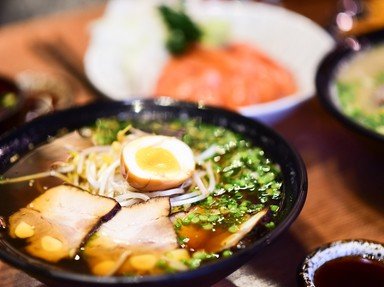Quiz Answer Key and Fun Facts
1. Ramen is a traditional Japanese dish that finds it roots in the Chinese noodle dishes of the early 20th century. Immigrants that lived in the Chinatown of which Japanese port city (located near Tokyo) helped popularize the dish?
2. Shoyu ramen can be found in many Japanese ramen restaurants. Which of these popular broth enhancers ("tare") is included to make the clear, dark broth?
3. Many Japanese restaurants will give you the option to add "chashu" to your ramen. What kind of meat is chashu typically made from?
4. The broth for this version of ramen is made specifically from pork bones, giving it a cloudy, brownish color. What kind of ramen broth is it?
5. Named for the Naruto whirlpools of Japan, "narutomaki" is a fun, colorful ramen topping added once cooking has completed. What is the main ingredient used when making "narutomaki"?
6. A specialty of Sapporo, Japan, this version of ramen uses a special soybean-based ingredient for its broth. Which of these is it?
7. You may happen across the ingredient known as "menma" in Japanese when eating a bowlful of steaming ramen. Located on the righthand side of this photo, what would you be eating?
8. When creating a ramen dish, one of the most important distinctions is whether your dish will be "chintan" or "paitan." What is the distinction that you are making when deciding on one of these two options?
9. While dining at a ramen restaurant, sides such as "karaage" (deep-fried chicken) and these delicious fried dumplings might be on offer. What are these dumplings called in Japanese?
10. Instant ramen was invented in 1958 by Momofuku Ando amidst a food shortage in post-WWII Japan. What ingredient, most commonly supplied by the United States at that time, convinced Ando to come up with his innovation?
Source: Author
trident
This quiz was reviewed by FunTrivia editor
Bruyere before going online.
Any errors found in FunTrivia content are routinely corrected through our feedback system.
